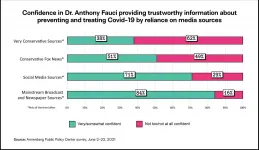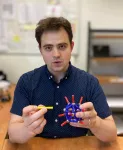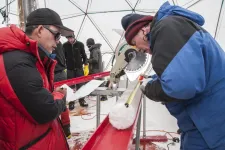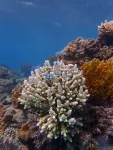Using snakes to monitor Fukushima radiation
Researchers placed tiny GPS trackers on rat snakes to track their movements at Fukishima
2021-07-20
(Press-News.org) Ten years after one of the largest nuclear accidents in history spewed radioactive contamination over the landscape in Fukushima, Japan, a University of Georgia study has shown that radioactive contamination in the Fukushima Exclusion Zone can be measured through its resident snakes.
The team's findings, published in the recent journal of Ichthyology & Herpetology, report that rat snakes are an effective bioindicator of residual radioactivity. Like canaries in a coal mine, bioindicators are organisms that can signal an ecosystem's health.
An abundant species in Japan, rat snakes travel short distances and can accumulate high levels of radionuclides. According to the researchers, the snakes' limited movement and close contact with contaminated soil are key factors in their ability to reflect the varying levels of contamination in the zone.
Hanna Gerke, an alumna of UGA's Savannah River Ecology Laboratory and the Warnell School of Forestry and Natural Resources, said tracked snakes moved an average of just 65 meters (approximately 213 feet) per day.
"Our results indicate that animal behavior has a large impact on radiation exposure and contaminant accumulation," Gerke said. "Studying how specific animals use contaminated landscapes helps increase our understanding of the environmental impacts of huge nuclear accidents such as Fukushima and Chernobyl."
Why are snakes a good indicator of radioactive contamination?
James C. Beasley, Gerke's advisor during the study, said snakes can serve as better indicators of local contamination in the zone than more mobile species like East Asian raccoon dogs, wild boar and song birds.
"Snakes are good indicators of environmental contamination because they spend a lot of time in and on soil," said Beasley, associate professor at SREL and Warnell. "They have small home ranges and are major predators in most ecosystems, and they're often relatively long-lived species."
The team identified 1,718 locations of the snakes while tracking them for over a month in the Abukuma Highlands, approximately 15 miles northwest of the Fukushima Daiichi Nuclear Power Plant. The paper's findings reinforce the team's previous study published in 2020, which indicated the levels of radiocesium in the snakes had a high correlation to the levels of radiation in the soil where the snakes were captured.
How to track snakes
To determine where the snakes were spending their time and how far they were moving, the team tracked nine rat snakes using a combination of GPS transmitters and manual very-high frequency tracking. Beasley said VHF transmitters allowed the team to physically locate a snake every few days to identify if it was underground or in arboreal habitat.
The researchers placed the transmitters on the rear back of the snakes. Tape was initially placed around the snakes. Then superglue was used to ensure the transmitters were secured to the tape. This allowed the transmitters to easily be removed from the animals at the conclusion of the study.
Working in the hilly, rugged terrain of abandoned villages and farms, the team located snakes in trees, grasslands and along roadside streams. Gerke said the snakes avoided the interior of conifer forests but were often found in deciduous forests, along forest edges and inside of abandoned buildings. More than half of the tracked snakes, she said, spent time in abandoned barns and sheds, which can help shield them from contamination in the surrounding soil.
During winter months, their risk of exposure likely increases when they seek shelter underground, close to the more heavily contaminated soils. Future work to clarify the link between the micro-habitat use of species like snakes and their contaminant exposure, as well as the potential health risks to snakes and other wildlife due to increased radiation exposure, will be critical to understanding the effects of the Fukushima Daiichi accident on local wildlife populations.
INFORMATION:
Thomas G. Hinton served as coauthor on the study, Institute of Environmental Radioactivity, Fukushima University, Fukushima, Japan; Centre for Environmental Radioactivity, Norwegian University of Life Sciences, Faculty for Environmental Sciences and Nature Research Management, Aas, Norway.
The full study is available online at https://meridian.allenpress.com/copeia/article-abstract/109/2/545/467583/Movement-Behavior-and-Habitat-Selection-of-Rat?redirectedFrom=fulltext
[Attachments] See images for this press release:
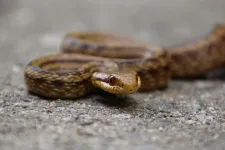
ELSE PRESS RELEASES FROM THIS DATE:
2021-07-20
A recent study led by Geoff Burns, an elite runner and postdoctoral researcher at the University of Michigan Exercise & Sport Science Initiative, compared the "bouncing behavior"--the underlying spring-like physics of running--in elite-level male runners (sub-four-minute milers) vs. highly trained but not elite runners.
Subjects ran on a treadmill instrumented with a pressure plate beneath the belt, so Burns and colleagues could see how much time they spent in the air and in contact with the ground. When running, muscles and limbs coordinate to act like a giant pogo stick, and those muscles, tendons and ligaments interact to recycle energy from step to step, Burns says.
The researchers looked at the basic physics of the runners ...
2021-07-20
Routine adolescent preventive visits provide important opportunities for promoting sexual and reproductive health and for preventing unintended pregnancy and sexually transmitted infections.
A new study END ...
2021-07-20
We all like to think that we know ourselves best, but, given that our brain activity is largely governed by our subconscious mind, it is probably our brain that knows us better! While this is only a hypothesis, researchers from Japan have already proposed a content recommendation system that assumes this to be true. Essentially, such a system makes use of its user's brain signals (acquired using, say, an MRI scan) when exposed to a particular content and eventually, by exploring various users and contents, builds up a general model of brain activity.
"Once we obtain the 'ultimate' brain model, we should be able to perfectly estimate the brain activity of ...
2021-07-20
July 19, 2021 - At the organization responsible for certifying the training and skills of US urologists, achieving and maintaining diversity, equity and inclusion is more than just a "numbers game," according to a special article in Urology Practice®, an Official Journal of the American Urological Association (AUA). The journal is published in the Lippincott portfolio by Wolters Kluwer.
In the new article, the American Board of Urology (ABU) points out that the practice of diversity and inclusion has been a cornerstone of its values for years. However, the Board acknowledges that while progress has been made, ...
2021-07-20
With more than two-thirds of American adults vaccinated with at least one dose of an authorized Covid-19 vaccine, the top U.S. health agencies retain the trust of the vast majority of the American public, as does Dr. Anthony Fauci, the public face of U.S. efforts to combat the virus, according to a new survey from the Annenberg Public Policy Center (APPC) of the University of Pennsylvania.
The survey revealed growing public confidence in both the safety and effectiveness of vaccines to prevent Covid-19.
But after months of attacks on Fauci in conservative and social media, the survey found that people who said they rely on conservative and very conservative media rather than other sources ...
2021-07-20
Led by Dr Jonas Warneke, researchers at the Wilhelm Ostwald Institute of Physical and Theoretical Chemistry at Leipzig University have made a decisive advance in the study of one type of highly reactive particles. Based on their research, they now understand the "binding preferences" of these particles.
Their research serves as the basis for the targeted use of these highly reactive molecules, for example, to generate new molecular structures or to bind hazardous chemical "waste" and in this way dispose of it. The researchers have now published their findings in the journal Chemistry - A European Journal, and their research was featured on the cover thanks to the excellent review they received.
What molecules and people have in common
Molecules and people actually have a lot in ...
2021-07-20
COLUMBUS, Ohio - Scientists who study glacier ice have found viruses nearly 15,000 years old in two ice samples taken from the Tibetan Plateau in China. Most of those viruses, which survived because they had remained frozen, are unlike any viruses that have been cataloged to date.
The findings, published today in the journal Microbiome, could help scientists understand how viruses have evolved over centuries. For this study, the scientists also created a new, ultra-clean method of analyzing microbes and viruses in ice without contaminating it.
"These glaciers were formed gradually, and along with dust and ...
2021-07-20
In order to correctly separate vehicles into classes, for instance for mobility pricing, one must be able to clearly distinguish mid-sized cars from upper class cars or small cars from compact cars. But this is becoming increasingly difficult: On photos, an Audi A4 looks almost the same as an Audi A6, a Mini One looks similar to a Mini Countryman. To date, there is no independent procedure for doing this.
Thus far, the classes in each country have been determined by experts - to a large extend at their own discretion. Empa researcher Naghmeh Niroomand has now developed a system that can classify cars worldwide based on their dimensions. Purely mathematical and fair. Thanks to it, the current classification ...
2021-07-20
FORT LAUDERDALE/DAVIE, Fla. - It's good to have friends.
Most humans have experienced social anxiety on some level during their lives. We all know the feeling - we show up to a party thinking it is going to be chock full of friends, only to find nearly all total strangers. While we typically attribute the long-lasting bonds of social familiarity to complex thinkers like humans, growing evidence indicates that we underestimate the importance of friendship networks in seemingly "simple" animals, like fish, and its importance for survival in the wild. To better understand how familiarity impacts social fishes, a group of research scientists studied this idea using schooling coral reef fish.
"We studied how the presence of ...
2021-07-20
FRANKFURT, GERMANY. When SARS-CoV-2 infects a cell, it introduces its RNA into it and re-programmes it in such a way that the cell first produces viral proteins and then whole viral particles. In the search for active substances against SARS-CoV-2, researchers have so far mostly concentrated on the viral proteins and on blocking them, since this promises to prevent, or at least slow down, replication. But attacking the viral genome, a long RNA molecule, might also stop or slow down viral replication.
The scientists in the COVID-19-NMR consortium, which is coordinated by Professor Harald Schwalbe from the Institute of Organic Chemistry and Chemical Biology at Goethe University, have now completed an important ...
LAST 30 PRESS RELEASES:
[Press-News.org] Using snakes to monitor Fukushima radiation
Researchers placed tiny GPS trackers on rat snakes to track their movements at Fukishima

